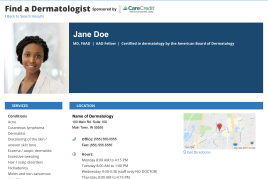Collaborating to improve joint and skin care
A joint rheumatology-dermatology clinic streamlines and improves patient care and physician education.
Dr. Berhanu's story

Dermatologist Alison Ehrlich, MD, championed the clinic, and it is now moving into its third year. Many rheumatic diseases manifest in the skin, so the clinic has been wonderful in coordinating care for patients and managing their conditions together. It’s extremely helpful to continue learning from each other and seeing how diseases co-present. Skin symptoms and joint symptoms do not always respond equally to therapies, so while the skin might respond well to a specific therapy, the joints will require something else. We can consult with dermatologists, and them with us.
From the patients’ perspective, they love that they don’t have to go to two different appointments and that we are communicating on the back end. We’re able to provide one set of clear instructions for patients — reducing or even eliminating conflicting treatment plans — and circumvent the intermediary role patients are often forced to play between specialists.
Before the combined clinic was established, if I wanted a skin biopsy of a rash, I would send my patient over to the dermatology clinic. Dermatology would accommodate them as quickly as possible, but the rash may have gone away before their appointment. So this joint clinic streamlines our care when both specialists can see the patient, consult with each other and make decisions together. It also benefits the residents we train in the clinic. They are able to work firsthand with colleagues in a different specialty and better understand the diseases they treat. Joint rheumatology-dermatology clinics are a relatively new concept, and this could be a model for others.
Rheumatologists and dermatologists take care of complex and often rare diseases. Patients with both rheumatic and skin disease benefit from collaboration to establish diagnoses and develop comprehensive treatment plans.
The dermatologist's perspective
"In our combined clinic, we are able to discuss the patient's issues together, both from the rheumatology and dermatology standpoints. We come up with a combined treatment plan, and the patients get the benefit of both specialists in one afternoon. We learn tremendously from each other, and I appreciate the collegiality."
– Alison Ehrlich, MD
George Washington University
Patient & physician stories
Learn how board-certified dermatologists have helped patients with serious skin disease and collaborated with other doctors to enhance patient care.
Browse all stories Make it easy for patients to find you.
Make it easy for patients to find you.
 Meet the new AAD
Meet the new AAD
 2022 AAD VMX
2022 AAD VMX
 AAD Learning Center
AAD Learning Center
 Need coding help?
Need coding help?
 Reduce burdens
Reduce burdens
 Clinical guidelines
Clinical guidelines
 Why use AAD measures?
Why use AAD measures?
 Latest news
Latest news
 New insights
New insights
 Combat burnout
Combat burnout
 Joining or selling a practice?
Joining or selling a practice?
 Advocacy priorities
Advocacy priorities
 Promote the specialty
Promote the specialty
